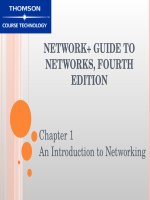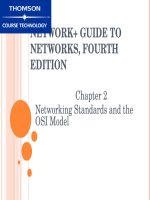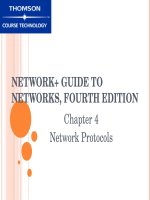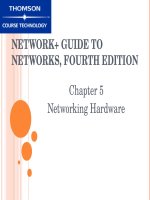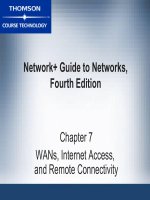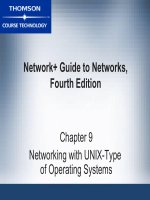Guide to network essentials 4th chapter 09
Bạn đang xem bản rút gọn của tài liệu. Xem và tải ngay bản đầy đủ của tài liệu tại đây (701.43 KB, 36 trang )
Chapter 9:
Understanding Complex
Networks
Learning Objectives
Discuss interconnectivity issues in a
multivendor environment
Define the various options to implement a
multivendor network environment
Discuss the differences between centralized
and client/server computing
Define the client/server networking
environment
Discuss the basics of Web-based computing
environments
Guide to Networking Essentials, Fou
2
Interconnectivity in Multivendor
Environments
Today’s networks include computers and
equipment from various vendors
Big dilemma is connecting systems using
different network operating systems
Server’s
operating system, client’s operating system,
and redirectors must be compatible
Figure 9-1 shows that Windows Server 2003
supports many different client operating systems
Guide to Networking Essentials, Fou
3
Windows Server 2003
Supports Many Clients
Guide to Networking Essentials, Fou
4
Implementing Multivendor Solutions
Two basic ways to handle multivendor
connectivity
From
client end
From server end
Guide to Networking Essentials, Fou
5
Client-Based Solutions
Client’s redirector intercepts messages and
forwards them to correct server
Client-based multivendor solution
Multiple
redirectors loaded onto single client
Allows connections to different vendor’s servers
Figure 9-2 shows redirectors in multivendor
environment
Guide to Networking Essentials, Fou
6
Redirectors Make Multivendor
Connectivity Possible
Guide to Networking Essentials, Fou
7
Server-Based Solutions
Server-based multivendor solution
Software
loaded on server to provide service to
particular client
Service for Macintosh installed on Windows
server allows Macintosh clients
Service
automatically converts files to Macintosh
format when retrieving them from server
See Figure 9-3
Guide to Networking Essentials, Fou
8
Service for Macintosh on Windows 2000
Server
Guide to Networking Essentials, Fou
9
Vendor Options
Many NOSs are available from vendors
Four most popular networking product vendors are:
Microsoft
Novell
Linux
Apple
Many include utilities to allow simple
interconnectivity
See
Figure 9-4
Guide to Networking Essentials, Fou
10
Easy Client and Server Connectivity
Guide to Networking Essentials, Fou
11
Microsoft Redirector
Microsoft redirector included with most Microsoft
operating systems
Automatically
installed when operating system
is installed
Allow users to share resources with others on network
(peer-to-peer networking)
Guide to Networking Essentials, Fou
12
Microsoft in a Novell Network
Many products allow Windows client to connect
to Novell NetWare network, including:
NWLink
Client
Service for NetWare (CSNW)
Microsoft Service for NetWare Directory
Services
Guide to Networking Essentials, Fou
13
MS-DOS Clients
Utilities allow MS-DOS client to connect to
servers of different NOS vendors, including:
AppleShare
PC
LocalTalk card with firmware
UNIX-derived client software, such as Sun
Microsystem’s PC-NFS
Samba, add-on Linux server
Guide to Networking Essentials, Fou
14
Novell Networks
Provides file and print services for following clients:
MS-DOS-based
Windows
9x and ME
Windows 2000, XP, and NT
Apple Macintosh
UNIX/Linux
NetWare 6 includes platform-independent method
for accessing file and print servers,
as seen in Figure 9-5
Guide to Networking Essentials, Fou
15
NetWare WebAccess
Guide to Networking Essentials, Fou
16
Linux Networks
Network File System (NFS)
Lets
networked machine export portion of local file
system to authorized users on network
Exported part known as mount point or NFS volume
Preferred method of interconnection is adding
Samba service to Linux servers
Open-source
server-based solution
Allows Linux machine to masquerade as native
Microsoft network server using Server Message Block
(SMB)
Guide to Networking Essentials, Fou
17
Apple Macintosh
Includes OS files to communicate with AppleTalk
network
AppleShare automatically provides file sharing
Includes
print server to share printers
Guide to Networking Essentials, Fou
18
Mac OS-X
Newest version is major departure from previous
Mac OS versions
Includes client software for Windows and UNIX
environment
Built on UNIX core
Backward compatible support
Guide to Networking Essentials, Fou
19
Handheld Computing Environment
Fragmented market with no clear hardware or
software standard
Challenge to integrate handheld devices into
corporate computing environment
Devices rarely connect to corporate LAN, but
most offer Ethernet connection
Concern for security and data integrity
Software companies have programs for handling
synchronization, backup, and application loading
Guide to Networking Essentials, Fou
20
Integrating PDAs into the Corporate
Network
PDAs have progressed in their capabilities
Web browsers
E-mail clients
Wi-Fi connections
New capabilities provide challenges to network admin
Special web content
Access points
New applications required
Security concerns – WEP or WPA should be implemented
Guide to Networking Essentials, Fou
21
Centralized versus Client/Server
Computing
Centralized computing
Mainframes
perform all processing
Dumb terminals connect directly to mainframe
PCs and “thin clients” attach to terminal server
Greatly increases network traffic
Client/server computing
Replacing
many centralized applications
Guide to Networking Essentials, Fou
22
Understanding Terminal Services
Terminal Services allows clients to run complex
applications on thin client or bare bones PC
Transfers
burden of processing to server
Server sends screen updates to client
Good for older PCs, thin clients, and remote
users on slow connections
Requires servers with large amounts of RAM,
extensive hard disk space, and powerful CPUs
Guide to Networking Essentials, Fou
23
Thin-Client Computing
Thin clients connect to server to access
resources and run applications
Many advantages of thin clients, including:
No
removable storage so employees cannot
copy files or introduce viruses
No hard drive reduces viruses and provides
better reliability
Lower total cost than desktop PCs
Guide to Networking Essentials, Fou
24
Back to the Future:
The Mainframe Environment
Today, certain transaction-intensive applications
work well with mainframes
Uses
include large-scale airline, hotel, and
rental car applications
Mainframes remain viable processing model
Still
important computing resource today and
for foreseeable future
Guide to Networking Essentials, Fou
25

